Hina Tabassum
Hierarchical and Collaborative LLM-Based Control for Multi-UAV Motion and Communication in Integrated Terrestrial and Non-Terrestrial Networks
Jun 06, 2025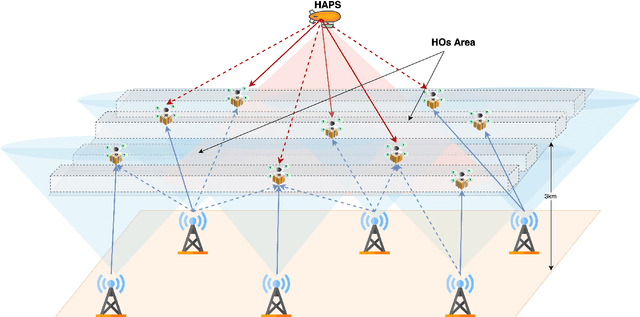
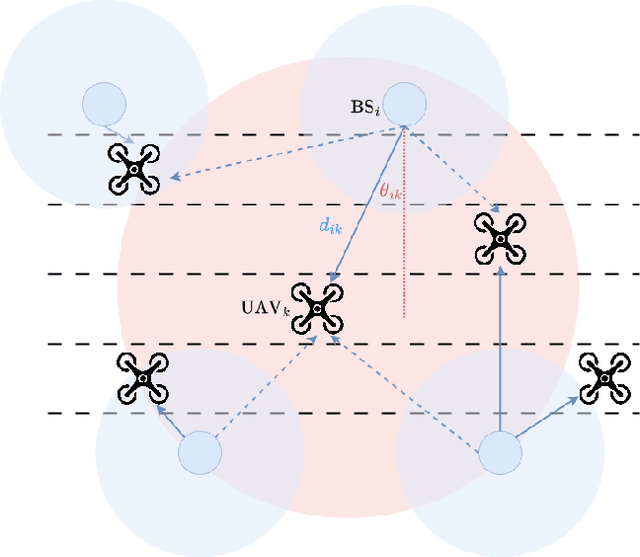
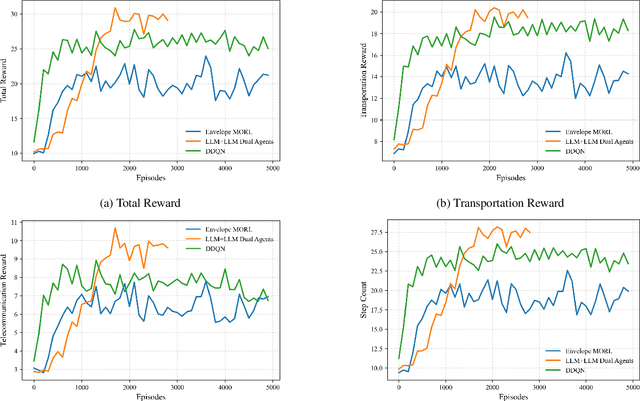
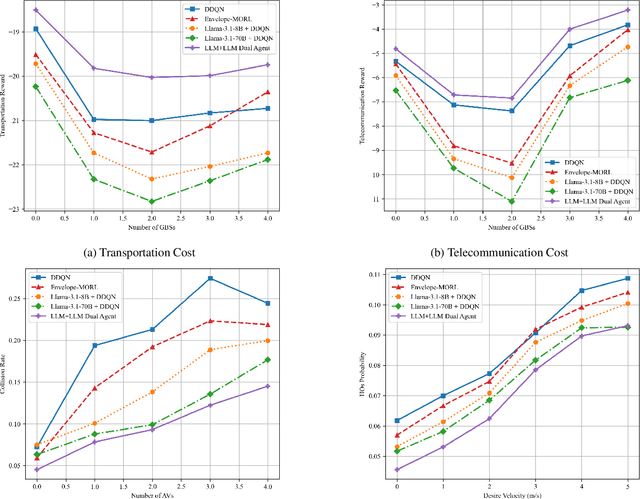
Abstract:Unmanned aerial vehicles (UAVs) have been widely adopted in various real-world applications. However, the control and optimization of multi-UAV systems remain a significant challenge, particularly in dynamic and constrained environments. This work explores the joint motion and communication control of multiple UAVs operating within integrated terrestrial and non-terrestrial networks that include high-altitude platform stations (HAPS). Specifically, we consider an aerial highway scenario in which UAVs must accelerate, decelerate, and change lanes to avoid collisions and maintain overall traffic flow. Different from existing studies, we propose a novel hierarchical and collaborative method based on large language models (LLMs). In our approach, an LLM deployed on the HAPS performs UAV access control, while another LLM onboard each UAV handles motion planning and control. This LLM-based framework leverages the rich knowledge embedded in pre-trained models to enable both high-level strategic planning and low-level tactical decisions. This knowledge-driven paradigm holds great potential for the development of next-generation 3D aerial highway systems. Experimental results demonstrate that our proposed collaborative LLM-based method achieves higher system rewards, lower operational costs, and significantly reduced UAV collision rates compared to baseline approaches.
EMForecaster: A Deep Learning Framework for Time Series Forecasting in Wireless Networks with Distribution-Free Uncertainty Quantification
Mar 31, 2025Abstract:With the recent advancements in wireless technologies, forecasting electromagnetic field (EMF) exposure has become critical to enable proactive network spectrum and power allocation, as well as network deployment planning. In this paper, we develop a deep learning (DL) time series forecasting framework referred to as \textit{EMForecaster}. The proposed DL architecture employs patching to process temporal patterns at multiple scales, complemented by reversible instance normalization and mixing operations along both temporal and patch dimensions for efficient feature extraction. We augment {EMForecaster} with a conformal prediction mechanism, which is independent of the data distribution, to enhance the trustworthiness of model predictions via uncertainty quantification of forecasts. This conformal prediction mechanism ensures that the ground truth lies within a prediction interval with target error rate $\alpha$, where $1-\alpha$ is referred to as coverage. However, a trade-off exists, as increasing coverage often results in wider prediction intervals. To address this challenge, we propose a new metric called the \textit{Trade-off Score}, that balances trustworthiness of the forecast (i.e., coverage) and the width of prediction interval. Our experiments demonstrate that EMForecaster achieves superior performance across diverse EMF datasets, spanning both short-term and long-term prediction horizons. In point forecasting tasks, EMForecaster substantially outperforms current state-of-the-art DL approaches, showing improvements of 53.97\% over the Transformer architecture and 38.44\% over the average of all baseline models. EMForecaster also exhibits an excellent balance between prediction interval width and coverage in conformal forecasting, measured by the tradeoff score, showing marked improvements of 24.73\% over the average baseline and 49.17\% over the Transformer architecture.
Semantic-Aware Adaptive Video Streaming Using Latent Diffusion Models for Wireless Networks
Feb 08, 2025Abstract:This paper proposes a novel framework for real-time adaptive-bitrate video streaming by integrating latent diffusion models (LDMs) within the FFmpeg techniques. This solution addresses the challenges of high bandwidth usage, storage inefficiencies, and quality of experience (QoE) degradation associated with traditional constant bitrate streaming (CBS) and adaptive bitrate streaming (ABS). The proposed approach leverages LDMs to compress I-frames into a latent space, offering significant storage and semantic transmission savings without sacrificing high visual quality. While it keeps B-frames and P-frames as adjustment metadata to ensure efficient video reconstruction at the user side, the proposed framework is complemented with the most state-of-the-art denoising and video frame interpolation (VFI) techniques. These techniques mitigate semantic ambiguity and restore temporal coherence between frames, even in noisy wireless communication environments. Experimental results demonstrate the proposed method achieves high-quality video streaming with optimized bandwidth usage, outperforming state-of-the-art solutions in terms of QoE and resource efficiency. This work opens new possibilities for scalable real-time video streaming in 5G and future post-5G networks.
CVaR-Based Variational Quantum Optimization for User Association in Handoff-Aware Vehicular Networks
Jan 14, 2025Abstract:Efficient resource allocation is essential for optimizing various tasks in wireless networks, which are usually formulated as generalized assignment problems (GAP). GAP, as a generalized version of the linear sum assignment problem, involves both equality and inequality constraints that add computational challenges. In this work, we present a novel Conditional Value at Risk (CVaR)-based Variational Quantum Eigensolver (VQE) framework to address GAP in vehicular networks (VNets). Our approach leverages a hybrid quantum-classical structure, integrating a tailored cost function that balances both objective and constraint-specific penalties to improve solution quality and stability. Using the CVaR-VQE model, we handle the GAP efficiently by focusing optimization on the lower tail of the solution space, enhancing both convergence and resilience on noisy intermediate-scale quantum (NISQ) devices. We apply this framework to a user-association problem in VNets, where our method achieves 23.5% improvement compared to the deep neural network (DNN) approach.
Over-the-Air FEEL with Integrated Sensing: Joint Scheduling and Beamforming Design
Jan 10, 2025



Abstract:Employing wireless systems with dual sensing and communications functionalities is becoming critical in next generation of wireless networks. In this paper, we propose a robust design for over-the-air federated edge learning (OTA-FEEL) that leverages sensing capabilities at the parameter server (PS) to mitigate the impact of target echoes on the analog model aggregation. We first derive novel expressions for the Cramer-Rao bound of the target response and mean squared error (MSE) of the estimated global model to measure radar sensing and model aggregation quality, respectively. Then, we develop a joint scheduling and beamforming framework that optimizes the OTA-FEEL performance while keeping the sensing and communication quality, determined respectively in terms of Cramer-Rao bound and achievable downlink rate, in a desired range. The resulting scheduling problem reduces to a combinatorial mixed-integer nonlinear programming problem (MINLP). We develop a low-complexity hierarchical method based on the matching pursuit algorithm used widely for sparse recovery in the literature of compressed sensing. The proposed algorithm uses a step-wise strategy to omit the least effective devices in each iteration based on a metric that captures both the aggregation and sensing quality of the system. It further invokes alternating optimization scheme to iteratively update the downlink beamforming and uplink post-processing by marginally optimizing them in each iteration. Convergence and complexity analysis of the proposed algorithm is presented. Numerical evaluations on MNIST and CIFAR-10 datasets demonstrate the effectiveness of our proposed algorithm. The results show that by leveraging accurate sensing, the target echoes on the uplink signal can be effectively suppressed, ensuring the quality of model aggregation to remain intact despite the interference.
Placement, Orientation, and Resource Allocation Optimization for Cell-Free OIRS-aided OWC Network
Jan 06, 2025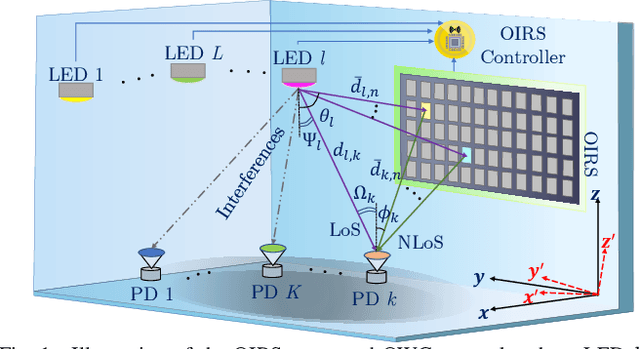
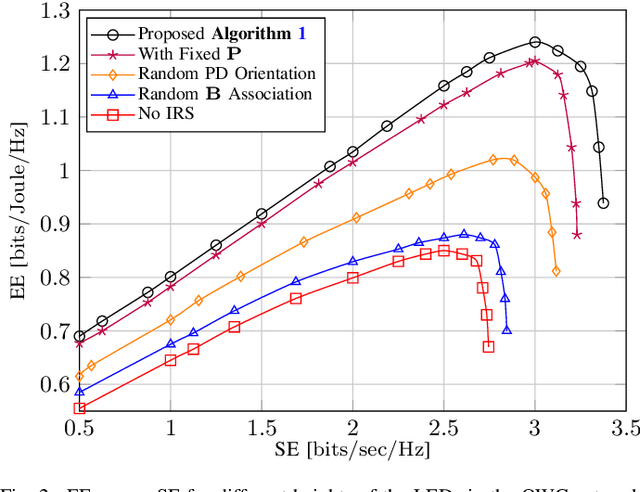
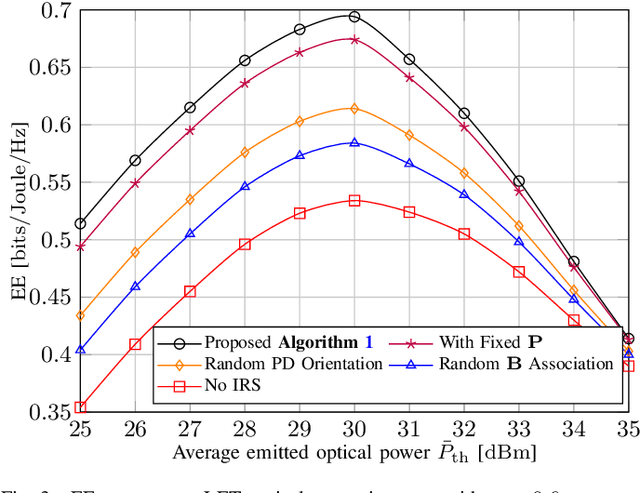
Abstract:The emergence of optical intelligent reflecting surface (OIRS) technologies marks a milestone in optical wireless communication (OWC) systems, enabling enhanced control over light propagation in indoor environments. This capability allows for the customization of channel conditions to achieve specific performance goals. This paper presents an enhancement in downlink cell-free OWC networks through the integration of OIRS. The key focus is on fine-tuning crucial parameters, including transmit power, receiver orientations, OIRS elements allocation, and strategic placement. In particular, a multi-objective optimization problem (MOOP) aimed at simultaneously improving the network's spectral efficiency (SE) and energy efficiency (EE) while adhering to the network's quality of service (QoS) constraints is formulated. The problem is solved by employing the $\epsilon$-constraint method to convert the MOOP into a single-objective optimization problem and solving it through successive convex approximation. Simulation results show the significant impact of OIRS on SE and EE, confirming its effectiveness in improving OWC network performance.
Unveiling the Potential of NOMA: A Journey to Next Generation Multiple Access
Dec 22, 2024



Abstract:Revolutionary sixth-generation wireless communications technologies and applications, notably digital twin networks (DTN), connected autonomous vehicles (CAVs), space-air-ground integrated networks (SAGINs), zero-touch networks, industry 5.0, and healthcare 5.0, are driving next-generation wireless networks (NGWNs). These technologies generate massive data, requiring swift transmission and trillions of device connections, fueling the need for sophisticated next-generation multiple access (NGMA) schemes. NGMA enables massive connectivity in the 6G era, optimizing NGWN operations beyond current multiple access (MA) schemes. This survey showcases non-orthogonal multiple access (NOMA) as NGMA's frontrunner, exploring What has NOMA delivered?, What is NOMA providing?, and What lies ahead?. We present NOMA variants, fundamental operations, and applicability in multi-antenna systems, machine learning, reconfigurable intelligent surfaces (RIS), cognitive radio networks (CRN), integrated sensing and communications (ISAC), terahertz networks, and unmanned aerial vehicles (UAVs). Additionally, we explore NOMA's interplay with state-of-the-art wireless technologies, highlighting its advantages and technical challenges. Finally, we unveil NOMA research trends in the 6G era and provide design recommendations and future perspectives for NOMA as the leading NGMA solution for NGWNs.
Hybrid LLM-DDQN based Joint Optimization of V2I Communication and Autonomous Driving
Oct 11, 2024Abstract:Large language models (LLMs) have received considerable interest recently due to their outstanding reasoning and comprehension capabilities. This work explores applying LLMs to vehicular networks, aiming to jointly optimize vehicle-to-infrastructure (V2I) communications and autonomous driving (AD) policies. We deploy LLMs for AD decision-making to maximize traffic flow and avoid collisions for road safety, and a double deep Q-learning algorithm (DDQN) is used for V2I optimization to maximize the received data rate and reduce frequent handovers. In particular, for LLM-enabled AD, we employ the Euclidean distance to identify previously explored AD experiences, and then LLMs can learn from past good and bad decisions for further improvement. Then, LLM-based AD decisions will become part of states in V2I problems, and DDQN will optimize the V2I decisions accordingly. After that, the AD and V2I decisions are iteratively optimized until convergence. Such an iterative optimization approach can better explore the interactions between LLMs and conventional reinforcement learning techniques, revealing the potential of using LLMs for network optimization and management. Finally, the simulations demonstrate that our proposed hybrid LLM-DDQN approach outperforms the conventional DDQN algorithm, showing faster convergence and higher average rewards.
Stochastic Sparse Sampling: A Framework for Variable-Length Medical Time Series Classification
Oct 08, 2024Abstract:While the majority of time series classification research has focused on modeling fixed-length sequences, variable-length time series classification (VTSC) remains critical in healthcare, where sequence length may vary among patients and events. To address this challenge, we propose $\textbf{S}$tochastic $\textbf{S}$parse $\textbf{S}$ampling (SSS), a novel VTSC framework developed for medical time series. SSS manages variable-length sequences by sparsely sampling fixed windows to compute local predictions, which are then aggregated and calibrated to form a global prediction. We apply SSS to the task of seizure onset zone (SOZ) localization, a critical VTSC problem requiring identification of seizure-inducing brain regions from variable-length electrophysiological time series. We evaluate our method on the Epilepsy iEEG Multicenter Dataset, a heterogeneous collection of intracranial electroencephalography (iEEG) recordings obtained from four independent medical centers. SSS demonstrates superior performance compared to state-of-the-art (SOTA) baselines across most medical centers, and superior performance on all out-of-distribution (OOD) unseen medical centers. Additionally, SSS naturally provides post-hoc insights into local signal characteristics related to the SOZ, by visualizing temporally averaged local predictions throughout the signal.
Molecular Absorption-Aware User Assignment, Spectrum, and Power Allocation in Dense THz Networks with Multi-Connectivity
Aug 06, 2024Abstract:This paper develops a unified framework to maximize the network sum-rate in a multi-user, multi-BS downlink terahertz (THz) network by optimizing user associations, number and bandwidth of sub-bands in a THz transmission window (TW), bandwidth of leading and trailing edge-bands in a TW, sub-band assignment, and power allocations. The proposed framework incorporates multi-connectivity and captures the impact of molecular absorption coefficient variations in a TW, beam-squint, molecular absorption noise, and link blockages. To make the problem tractable, we first propose a convex approximation of the molecular absorption coefficient using curve fitting in a TW, determine the feasible bandwidths of the leading and trailing edge-bands, and then derive closed-form optimal solution for the number of sub-bands considering beam-squint constraints. We then decompose joint user associations, sub-band assignment, and power allocation problem into two sub-problems, i.e., \textbf{(i)} joint user association and sub-band assignment, and \textbf{(ii)} power allocation. To solve the former problem, we analytically prove the unimodularity of the constraint matrix which enables us to relax the integer constraint without loss of optimality. To solve power allocation sub-problem, a fractional programming (FP)-based centralized solution as well as an alternating direction method of multipliers (ADMM)-based light-weight distributed solution is proposed. The overall problem is then solved using alternating optimization until convergence. Complexity analysis of the algorithms and numerical convergence are presented. Numerical findings validate the effectiveness of the proposed algorithms and extract useful insights about the interplay of the density of base stations (BSs), Average order of multi-connectivity (AOM), molecular absorption, {hardware impairment}, {imperfect CSI}, and link blockages.
 Add to Chrome
Add to Chrome Add to Firefox
Add to Firefox Add to Edge
Add to Edge